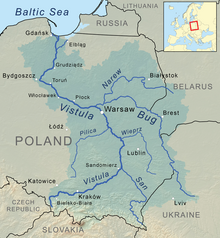| Narew Нараў, Нарев, Narevas | |
|---|---|
 Braided channels of the Narew at Strękowa Góra. Braided channels of the Narew at Strękowa Góra. | |
 Narew as part of the Vistula watershed. Narew as part of the Vistula watershed. | |
| Location | |
| Country | Poland, Belarus |
| Cities | |
| Voivodeships / Voblasts | Grodno, Podlaskie, Mazovian |
| Physical characteristics | |
| Source | |
| • location | north-eastern part of the Białowieża Forest near Dzikie Bagno, Belarus |
| • coordinates | 52°52′24.68″N 24°13′8.87″E / 52.8735222°N 24.2191306°E / 52.8735222; 24.2191306 |
| • elevation | 159 m (522 ft) |
| Mouth | Vistula |
| • location | Modlin (Nowy Dwór Mazowiecki), Poland |
| • coordinates | 52°26′01″N 20°40′33″E / 52.4335°N 20.6759°E / 52.4335; 20.6759 |
| • elevation | 70.7 m (232 ft) |
| Length | 499 km (310 mi) |
| Basin size | 74,527 km (28,775 sq mi) |
| Discharge | |
| • location | mouth |
| • average | 313 m/s (11,100 cu ft/s) |
| Discharge | |
| • location | entering Pułtusk |
| • average | 146 m/s (5,200 cu ft/s) |
| Basin features | |
| Progression | Vistula→ Baltic Sea |
The Narew (; Belarusian: Нараў, romanized: Naraŭ; Lithuanian: Narevas or Naruva) is a 499-kilometre (310 mi) river primarily in north-eastern Poland. It is a tributary of the river Vistula. The Narew is one of Europe's few braided rivers, the term relating to the twisted channels resembling braided hair. Around 57 kilometres (35 mi) of the river flows through western Belarus.
Etymology
The name of the river is from a Proto-Indo-European root *nr primarily associated with water (compare Neretva, Neris, Ner and Nur) or from a Lithuanian language verb nerti associated primarily with diving and flood.
Name of the lower portion
The portion of the river between the junctions with the Western Bug and the Vistula is also known as the Bugonarew, Narwio-Bug, Narwo-Bug, Bugo-Narew, Narwiobug or Narwobug. At the confluence near Zegrze the Bug is 1.6x longer, drains a 1.4x larger basin, and has a slightly greater average discharge (158 m³/s at Wyszków vs 146 m³/s at Pułtusk for the Narew, both ~25 km above the junction). Thus the Bugonarew was often considered part of the Bug river and the Narew a right tributary of the Bug.
On December 27, 1962, Prime Minister Józef Cyrankiewicz abolished the name Bugonarew soon after the Zegrze Reservoir had been constructed. Since then the river Bug has officially been considered part of the river Narew's system, with the Bug being a left tributary of the Narew (by this classification, the River Narew is a right tributary of the River Vistula). The name Bugonarew however is still used, especially by the inhabitants of local towns, such as Pułtusk.
Geography
The Narew flows through the geographical region of Europe known as the Wysoczyzny Podlasko – Bialoruskie (English: Plateau of Podlasie and Belarus) located within the Podlaskie Voivodeship and Masovian Voivodeship of Poland and the Hrodna Voblast of Belarus.
| Country | Length | Basin Area |
|---|---|---|
| Belarus | 57 kilometres (35 mi) | |
| Poland | 443 kilometres (275 mi) | 53,846 square kilometres (20,790 sq mi) |
| Total | 499 kilometres (310 mi) | 74,527 square kilometres (28,775 sq mi) |
The Narew is the fifth longest Polish river.

Cities and towns




Tributaries

History
On August 23, 1939, the Soviet Union and Germany signed the Molotov–Ribbentrop Pact, agreeing to divide Poland along the Narew, Vistula (Wisła), and San rivers.
On September 6, 1939, Polish military forces attempted to use the Narew as a defense line against German attack during the German invasion of Poland. This was abandoned the next day in favor of the Bug as German forces had already penetrated the defenses.
The Battle of Wizna was fought along the banks of the river between September 7 and September 10, 1939, between the forces of Poland and Germany during the initial stages of Invasion of Poland. Because it consisted of a small force holding a piece of fortified territory against a vastly larger invasion for three days at great cost before being annihilated with no known survivors, Wizna is sometimes referred to as a Polish Thermopylae in Polish culture.
On September 17, 1939, the USSR invaded Poland. By 28 September, the Soviet Army had reached the line of the rivers Narew, Bug River, Vistula and San – completing the division of Poland as negotiated in advance.
See also
References
- Witold Mańczak (1999). Wieża Babel (in Polish). Wrocław: Zakład Narodowy im. Ossolińskich. ISBN 83-04-04463-3.
- "Narew". mazowsze.szlaki.pttk.pl. Retrieved 13 August 2018.
- (in Polish) "Monitor Polski" 1963, nr 3, poz. 6
- ^ Statistical Yearbook of the Republic of Poland 2017, Statistics Poland, p. 85-86
External links
| Vistula River | |
|---|---|
| Tributaries | |
| Cities | |
| Notable crossings | |
| Channels and artificial waterways | |
| Historical and prehistoric inhabitants | |
| Related articles |
|
| Tributaries of the Vistula River | ||
|---|---|---|
| Forming rivers |
|  |
| Main tributaries of the left bank | ||
| Main tributaries of the right bank |
| |
| Distributary |
| |
| Vistula | |
|---|---|
| Odra | |
| Vistula Lagoon | |
| Baltic Sea | |